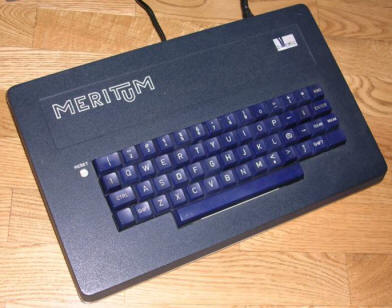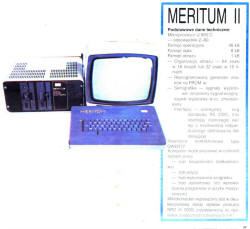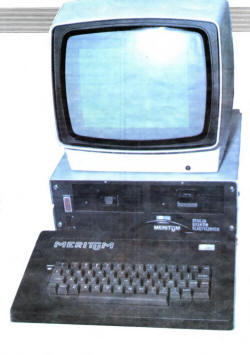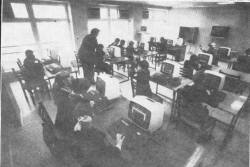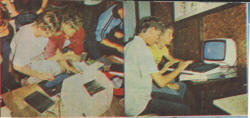Meritum
One of the first microcomputers made in Poland,
Meritum was TRS-80 Model 2 based computer. Designed in 1983, it was
manufactured in Mera Elzab - factory, which produced electronic
measuring devices.
Unfortunately, it was not popular. First, it was too slow, considered
obsolete even before introduction. More, it has no graphics mode - only
alternative character set to draw tables, and first version had no
floppy disk drive support.
In 1985 Model 2 was released, which had a floppy drive support and could
be tailored to customer's needs - RAM could be expanded to 32 or 48kB,
serial port could be changed to needs. Unfortunately it was still
obsolete computer, with almost no compatible software in Europe, so its
popularity wasn't big. Moreover, because Hungarian and Bulgarian floppy
drives were not good, so engineers quickly decided to use better drives
from East Germany. It was a big mistake, because East Germany factory
was falling behind with dispatching orders for internal computer
factories! This lead to higher import duties and higher prices of floppy
drives. And Meritum half-switching power supplies, they heated a lot and
burned quickly.
So, if executives can wait half a year and buy Spectrum with Microdrive
or Timex with FDD, and enjoy existing big software library, OR they can
buy a Meritum in 2 months, but for more money and with almost no
software (with floppy disk drive - if lucky), it was quite obvious that
the first option was better.
Meritum was also rejected as an educational computer, because of its
lack of graphic modes. Instead of it Elwro 800 Junior was introduced.
| Manufacturer | Mera-Elzab | |||
| Origin | Poland | |||
| Year of unit | 1986 | |||
| Year of introduction | 1983/85 (Model 2) | |||
| End of production | 1988 (1987) | |||
| CPU | Z80 clone (U880D) | |||
| Speed | 1.67MHz | |||
| RAM | 16/32/48/64K | |||
| ROM | 14K (Basic) | |||
| Colors: | Monochrome | |||
| Sound: | 1 channel | |||
| OS: | Basic MER-DOS (in Floppy, Model 2) CP/M (in Floppy, Model 2) |
|||
| Display modes: | Text: 32x16, 64x16 Graphics: Semigraphics with alternative character set. |
|||
| Media: |
Tape External FDD |
|||
|
Power supply:
|
||||
| I/O: | Parallel interface Serial interface Tape connector External FDD connector (Model 2) |
|||
| Possible upgrades: | Not much known, Memory to 64K, but I don't know how about addressing. Some internal components can be upgraded by adding pre-made boards. | |||
|
|
||||
|
(a Meritum logo) |
||||
| Software accessibility: | Impossible. | |||
You can emulate Meritum in MESS by using ROMs stored in meritum and meritum_net folders in MESS ROMS directory. Emulation is bad. In net version cassette writing routines are bad, my unit, which uses the same ROMs works well with cassette, emulated unit produces unreadable WAV files. Keyboard emulation is unstable. But it works.
| Contents: | Starting | Making tapes, floppies | Pinouts | Monitor | Links |
Starting:
In many ROM revisions it asks first about memory to
reserve. It can be: "MEMORY SIZE" or in Polish: "OBSZAR PAO". The last
word here is abbreviation of "PAmięć Operacyjna" - RAM. Press Return to
enter BASIC.
Some very rare units are modified to boot MER-DOS or CP/M Disk operating
system. This means that it has no BASIC in ROM, it has only code to boot
system from floppy. If it can't boot, it'll display error and jump to
monitor built instead of BASIC.
Currently (2011) there's no emulator of it. There's no dedicated
software on the Internet. The only programs you can get are type-ins
from Polish magazines Bajtek, Informik etc., they're quite accessible (search
for RetroReaders forum, but it may change).
The biggest problem with this computer is its unstability with graphics juggling. To check if your computer is affected, test it with this program:
10 RANDOM
20 CLS
30 FOR I=0 TO 2000
40 SET (RND(127),RND(47))
50 NEXT I
60 GOTO 20
70 END
If it hangs while operating graphics, the first reason
is unstable power supply, Next, check memory. The glue logic isn't
usually a problem except beige Soviet chips, they are likely to fail in
thermal conditions.
More information about type-ins in Machine code. Most type-ins in machine code work well in Meritum I, but fail in Disk Meritum (Meritum II or Meritum I Model 2) - it is because USR command is handled different way. So in Meritum I it was:
POKE 16526,A : POKE 16527,B
X=USR(0)
Meritum II allows to define a few USR machine code programs, so it will look like:
DEFUSR0=A+256*B
X=USR(0)
You may also encounter some problems with parsing hex data.
More information in Polish:
-
![]() Uruchamianie Mikrokomputera Meritum, Piszemy program w Meritum Basic,
Niskorozdzielcza grafika Meritum - from "Mikrokomputer w szkole i w
domu", K. Socha. (Starting Meritum microcomputer, writing programs
in Meritum Basic, Low-resolution Meritum graphics)
Uruchamianie Mikrokomputera Meritum, Piszemy program w Meritum Basic,
Niskorozdzielcza grafika Meritum - from "Mikrokomputer w szkole i w
domu", K. Socha. (Starting Meritum microcomputer, writing programs
in Meritum Basic, Low-resolution Meritum graphics)
-
![]() Komputery osobiste w Polsce - from Kuryłowicz, Madej, Marasek -
"Komputery Osobiste" (Personal Computers in Poland)
Komputery osobiste w Polsce - from Kuryłowicz, Madej, Marasek -
"Komputery Osobiste" (Personal Computers in Poland)
-
![]() Meritum
- opis języka BASIC - from Frelek B. "Mikrokomputer - Programowanie
w języku BASIC" (description of Meritum Basic)
Meritum
- opis języka BASIC - from Frelek B. "Mikrokomputer - Programowanie
w języku BASIC" (description of Meritum Basic)
Tapes, Floppies:
Currently (2011) noone in Poland bothers about this
computer, so there's no known method of archiving its software. Because
some disks are probably in CP/M like format (MER-DOS is not much
like CP/M, but it was possible to run CP/M on some Meritum), CP/M disk
archiving methods may work. Another disks and tapes may be in
TRS-80 like format, so simply putting them to universal CAS file should
do the job.
Meritum tape interface is 500-baud one, so low CAS tape images may be
playable.
In my fileland, there are some utilities to read TRS-80 disks and tapes,
and to convert high/low baud tape CAS files.
Meritum is a bit copied from TRS-80 Model 2, but I don't know for sure
is it program-compatible (it was one of design assumptions, but maybe
engineers abandoned it?).
Commands for loading/savinf are CSAVE "NAME" and CLOAD "NAME".
To verify use CLOAD?, it'll show "BAD" on screen if finds an error.
If you type CLOAD and hit return, it'll load the first BASIC program
it'll find. During loading two symbols (usually asterisk or rhomb)
appear on the upper right corner of screen. Loading is good if left one
lights steadily and right one blinks.
Loading machine code programs: Type SYSTEM [return] to get to the system mode, now type the first letter of program's name, hit Return and play the tape. If you don't know name, you can try or make Meritum display it. Displaying procedure has been described in Polish Bajtek Magazine, probably about 1986, but it doesn't work with my Meritum.
If a cassette played from PC doesn't work, try to invert waveform, for example in CoolEdit or Audacity. It may do the trick.
The software I recovered from my tapes (it's in fileland
in software directory) - currently there's only one small BASIC program.
It adds 3 options, which may be turned on or off by poke'ing memory:
- Keyboard auto-repeating
- Short beep after key pressing
- Disabling BREAK key.
By the way, there were 2 types of cassettes distributed
with Meritum:
- With blue printed label and text in 2 lines - these were original ones,
distributed with first units.
- With gray label, made on copier, text in 1 line (example)
- these were cheaper, distributed with later machines.
Pinouts
Video - the male DIN5 plug comes with a "tail" from case. It can be hidden in computer's case, but I don't recommend it. It fits into Neptun 156(b) monitor well.

| 1 - Composite out 2 - Ground 3 - Sound* 5 - +12V direct from power supply (not in all units) * - first versions had a speaker built-in in keyboard PCB. |
Serial port, in my unit it's Network port:
(by default it's 1200b/s, but it could be modified to order in 150 -
9600b/s)

| 1 - RTS 2 - Ground 3 - TxD 4 - CTS 5 - RxD |
Tape

| 1,4 - Tape out (from computer) 2 - Ground 5,3 - Tape in (to computer) |
Parallel and Floppy port:

The only thing I could get is an 8255 connection to parallel/floppy
connector. According to Technical Operational Manual, Centronics, IRPR
and Logabax interfaces require a special adapter.
| 1 - PB3 2 - PB2 3 - PB5 4 - PB6 5 - PA4 6 - PA2 7 - PC5 8 - PC2 9 - PC3 10 - PA0 11 - PC0 12 - RESIN 13 - 0V |
14 - PB0 15 - PB1 16 - PB4 17 - PB7 18 - PA6 19 - PA7 20 - PA5 21 - PC4 22 - PA3 23 - PA1 24 - PC1 25 - +5V (0.1A) |
There's a diagnostic edge connector on a mainboard. No idea what pinout it has.
Monitor
It's an undocumented feature of Meritum Model 1 - in Model 2 there's
no monitor, its space contains FDD access routines. It's the last 2kB of
14K ROM, BASIC takes only 12K.
To enter Monitor program, use:
>SYSTEM
*?/12288
*
Now you're in Monitor mode. There are 7 commands. All parameters in
hex:
- D addr1, addr2 - displays memory from addr1 to addr2
- T addr1, addr2;k - tests memory from addr1 to addr2 k times
- M addr, d - Browse mmeory from addr. D is not required, but if we enter
it, we can change byte to d. ENTER goes to next byte. Dot exits this
mode.
- PW addr, d - Write data d to port addr.
- PR addr - read from port addr
- X r - Display CPU registers, if r applied, it's register name (A, F, C,
D, E, H, L, M - (HL), S - (SP), P - (PC)), and the register can be
modified.
- E pc., addr - Jump to procedure which address is stored in P register or
address addr, if applied.
Links:
http://web.archive.org/web/20080405161706/http://www.e-service.net.pl/nfsk/komputery/meritum.html
- POLISH - Monitor explained.
http://web.archive.org/web/20120821231753/http://www.elwro.zafriko.pl/kat/mikrokomputery/mera_elzab_meritum_i
- General description
http://web.archive.org/web/20071110041320/http://www.e-service.net.pl/sumpirowicz/nfsk/komputery/meritum1.html
- Some interesting photos.
http://web.archive.org/web/20080217064926/http://www.e-service.net.pl/sumpirowicz/nfsk/komputery/meritum2.html
- More photo thumbnails.
http://web.archive.org/web/20161103165839/http://kupazlomu.ovh.org/kolekcja/merameritum2.htm - Brief
description in Polish.





